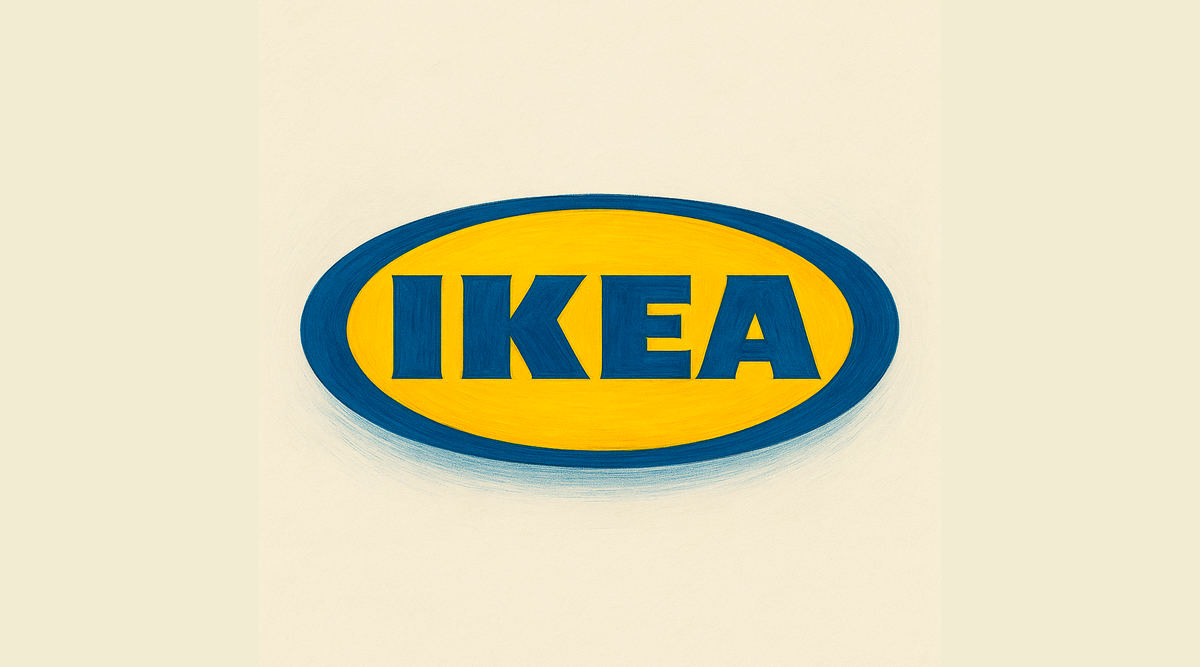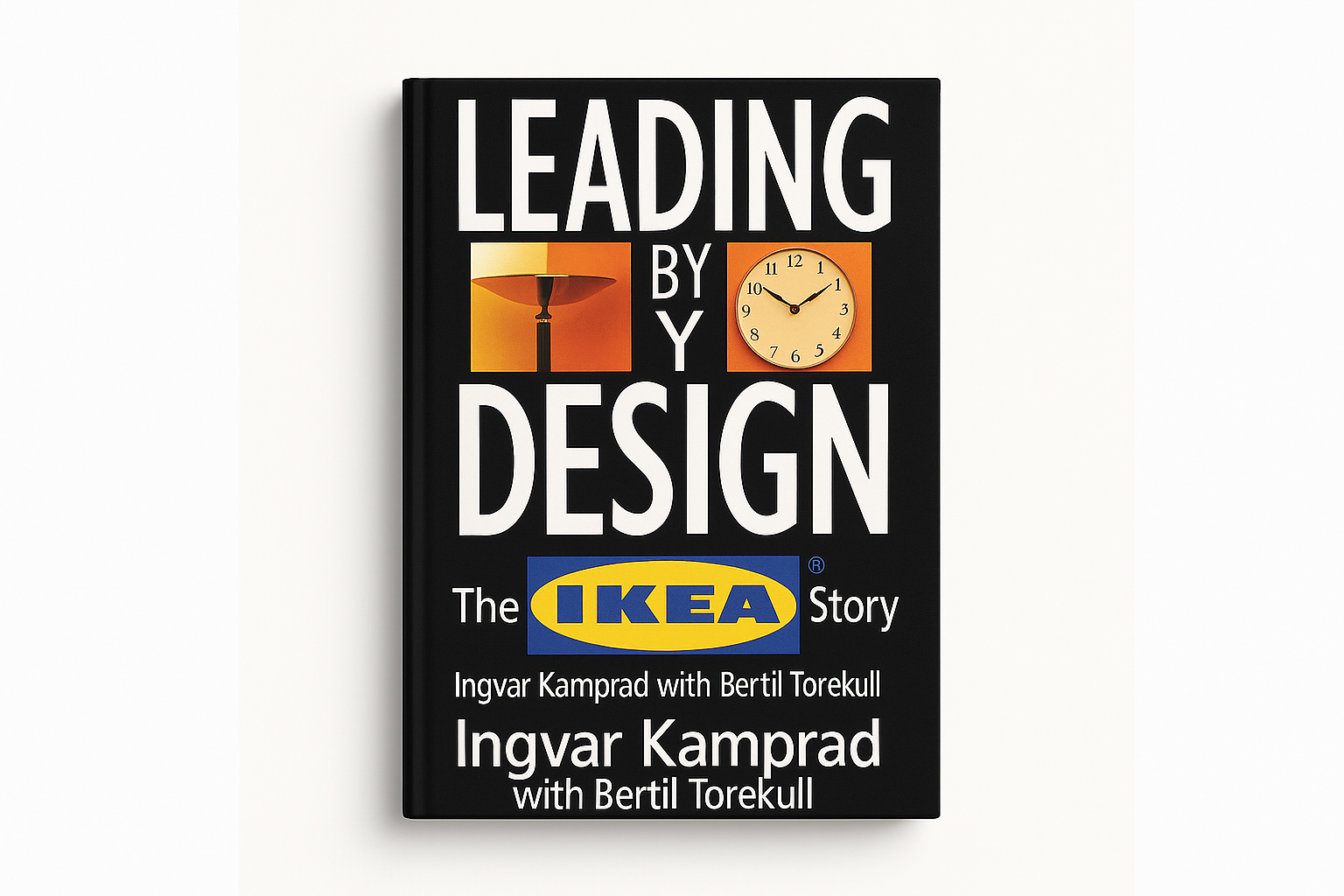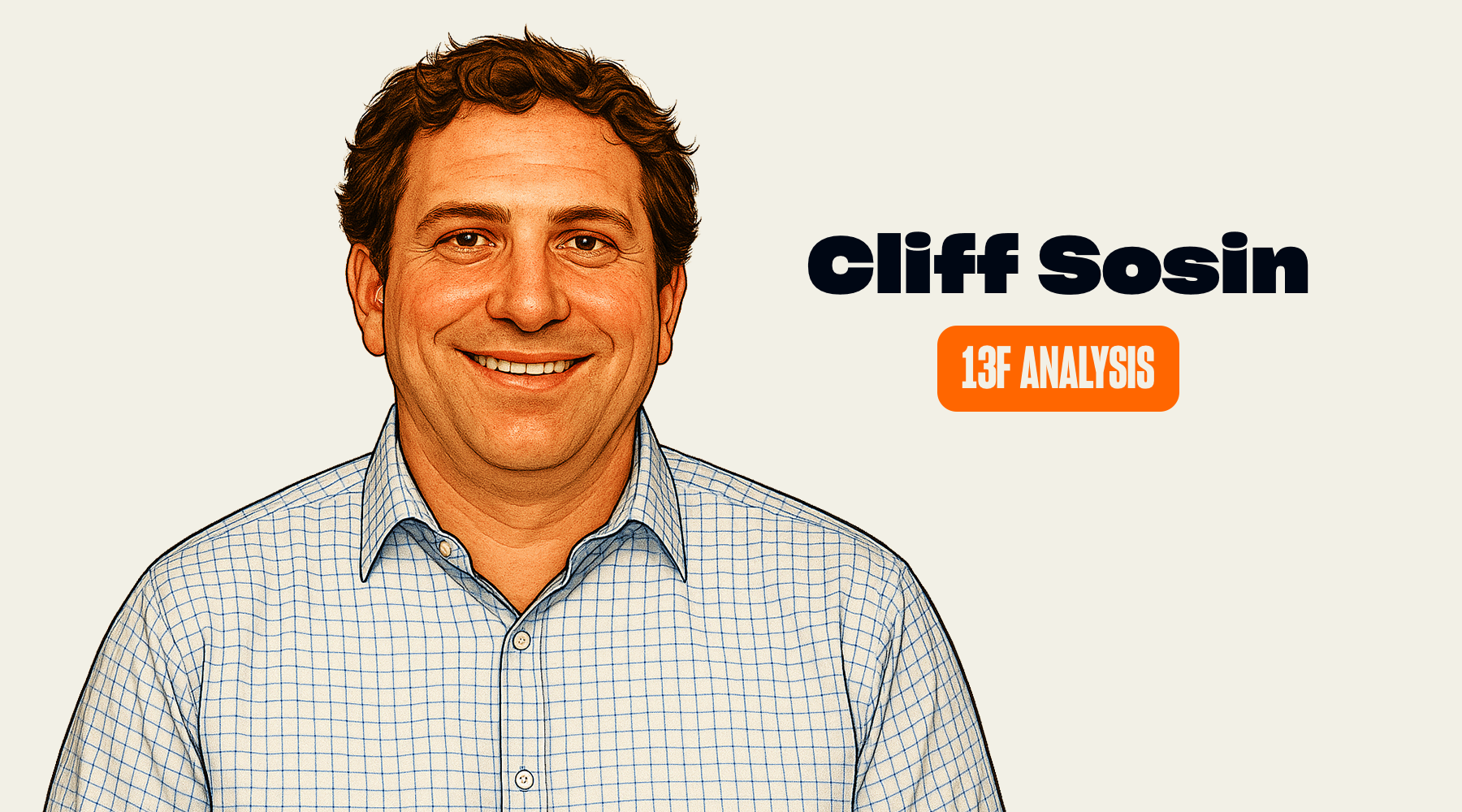Ingvar Kamprad started selling matches at 5 with one question: "Why do poor people have to put up with ugly things?" By refusing to accept that good design meant high prices, questioning every assumption ("Why can't customers assemble it themselves?"), and treating waste like a mortal sin, he built IKEA into the world's largest furniture retailer. Discover the counterintuitive principles that built a global empire in this Leading By Design: The IKEA Story book summary.
- Book: Leading By Design: The IKEA Story
- Author: Bertil Torekull (with Ingvar Kamprad)
- Pages: 302
- Rating: 5 out of 5 Stars
- Recommended for: Founders obsessed with democratizing quality, anyone fighting industry orthodoxy, entrepreneurs who believe constraints create better businesses
For more on IKEA, check out my in-depth business breakdown:

The 30-Second Summary
Ingvar Kamprad built IKEA from a mail-order business started at 17 into the world's largest furniture retailer by refusing to accept the industry's fundamental assumption: that quality furniture had to be expensive. His 74-year experiment proved that extreme frugality, constant questioning ("Why not flat-pack?"), and treating problems as opportunities could democratize good design. When competitors boycotted his suppliers, he designed his own furniture; when shipping damaged products, he invented customer assembly—accidentally discovering people value things more when they help create them.
In a nutshell: The path to serving "the many" requires questioning every assumption, turning constraints into innovations, and repeating core principles until they become religious doctrine.
About the Author
Bertil Torekull worked closely with Ingvar Kamprad for years to create this authorized biography, conducting extensive interviews when Kamprad was 72. Kamprad rejected all biography requests for a decade until Torekull suggested the book could serve as "study material for future entrepreneurs"—appealing to Kamprad's desire to democratize not just furniture, but business knowledge itself.
The 3 Big Ideas
1. Democratic Design Is a Moral Mission, Not a Market Position
From age 5, when Kamprad sold his first matches, he was haunted by a question: "Why do poor people have to put up with ugly things?" This wasn't about market segmentation—it was about justice. While competitors focused on wealthy elites, Kamprad declared: "We have decided once and for all to side with the many." This meant that every decision—from store locations to catalog design—had to serve the mission of making good design accessible to everyone.
The core insight: Serving "the many" isn't about going downmarket—it's about refusing to accept that quality belongs only to the wealthy.
IKEA proved that beautiful, functional design could be affordable by questioning every assumption. Why did furniture need to be pre-assembled? Why couldn't customers transport it themselves? Why did stores need expensive salespeople? Each sacred cow they slaughtered reduced costs while often improving the customer experience—people got their furniture immediately instead of waiting months for delivery.
Key takeaway: A moral mission to serve everyone forces innovations that a profit motive alone never would—constraints become creative fuel.
2. Every Attack Makes You Stronger (If You Think Like a Hydra)
When IKEA's prices became unbeatable, the National Association of Furniture Dealers organized a total supplier boycott. They described IKEA as "a monster with seven heads—if you cut off one, another soon grows." They meant it as an insult; Kamprad made it reality. The boycott forced three game-changing innovations that competitors couldn't copy.
The core insight: Industry orthodoxy's immune system rejection is exactly what forces you to evolve beyond the industry.
First, IKEA designed its own furniture (differentiation). Second, they sourced from Poland during communism's collapse (cost advantage). Third, when an employee suggested removing table legs to save space, they invented flat-pack furniture—reducing shipping costs 80% and accidentally discovering customers value things more when they participate in creating them (the "IKEA effect").
Key takeaway: When an entire industry unites against you, they're actually freeing you from their limitations—embrace the boycott.
3. Principles Are More Powerful Than Profits
Kamprad wrote IKEA's nine core principles in 1976 and preached them in the exact same sermon for 43 straight years. He called certain violations "mortal sins" (wasting resources, accepting conventional thinking) and distributed his "Testament of a Furniture Dealer" to 100,000+ employees. This wasn't corporate culture—it was corporate religion.
The core insight: Companies that last forever run on principles, not just profits—doctrine beats strategy.
The principles seem simple: "Expensive solutions are usually the work of mediocrity." "Only those who are asleep make no mistakes." "Ten minutes are a piece of yourself." But repeated religiously for decades, they created an operating system that survived founder transitions, economic crashes, and global expansion. When facing any decision, employees could ask: Does this serve the many? Does this reduce waste? Does this challenge convention?
Key takeaway: Write your principles when you're small, then repeat them unchanged until they become organizational DNA—consistency creates culture.
Key Frameworks
The Sacred Concept System
What it is: IKEA isn't a furniture company—it's a concept company where certain principles literally cannot be changed, creating predictability across decades and continents.
How to apply it:
- Define what's sacred and will never change (serving the many, low prices)
- Write it down formally as a "testament" or constitution
- Repeat the exact same message annually for decades
- Call violations "mortal sins" to create moral weight
- Make everything else changeable except these core principles
When to use it: When building something meant to outlast you and resist drift from its original mission.
The Democratic Design Formula
What it is: The systematic process of making quality accessible by questioning every assumption about how things "must" be done.
How to apply it:
- Start with the price the many can afford
- Work backwards to required cost structure
- Question every "necessary" expense
- Turn customer participation into value creation
- Make constraints force innovation
When to use it: When trying to democratize something currently reserved for elites—education, healthcare, technology, or any premium category.
The Problem-to-Possibility Pipeline
What it is: A systematic approach to converting every crisis into competitive advantage, based on IKEA's response to supplier boycotts.
How to apply it:
- Embrace the problem fully (don't minimize or deny)
- Ask "What does this force us to invent?"
- Look for solutions outside your industry
- Turn the constraint into a differentiator
- Document the innovation as a new principle
When to use it: When facing existential threats that seem unsolvable within current constraints.
Notable Quotes
"Why do poor people have to put up with ugly things?"
Why this matters: This childhood question became a 74-year mission—the best businesses solve moral problems, not just market problems.
"We have decided once and for all to side with the many."
Why this matters: This irreversible decision determines every other choice—strategy follows mission, not vice versa.
"Talk about profit margins! I still remember the lovely feeling. I can't have been more than five at the time."
Why this matters: True entrepreneurs have a physical reaction to profit—it's not greed but the joy of value creation.
"That couldn't be rational, and it wasted money."
Why this matters: Seeing waste where others see "normal" is the entrepreneur's gift—every inefficiency is an opportunity.
"Expensive solutions to any kind of problem are usually the work of mediocrity."
Why this matters: Constraints force genius; unlimited resources create lazy thinking—this principle built a $58 billion empire.
"Only those who are asleep make no mistakes."
Why this matters: Making mistakes is proof you're trying something new—fear of failure creates bureaucracy, which kills companies.
"An IKEA product without a price tag is always wrong."
Why this matters: Price transparency forces honest value creation—hiding prices means you're ashamed of your value proposition.
"Regard every problem as a possibility."
Why this matters: The supplier boycott that nearly killed IKEA created their entire competitive advantage—problems are just innovations in disguise.
"Ten minutes are not just one-sixth of your hourly pay. Ten minutes are a piece of yourself."
Why this matters: Time is the only non-renewable resource—wasting it is the only true mortal sin.
"If you are not enthusiastic about your job, a third of your life goes to waste."
Why this matters: Life is too short for work without meaning—find purpose or find another job.
"This was essentially the only real loan I have taken out in my life."
Why this matters: $63 for fountain pens, then built everything else through profits—self-financing forces discipline.
"IKEA was likened to a monster with seven heads: 'If you cut off one, another soon grows.'"
Why this matters: When competitors call you an unkillable monster, you've transcended competition into a new category.
"Why can't customers take it home today?"
Why this matters: The best innovations come from questioning delays everyone accepts as "necessary."
"I hope we will never have two identical stores."
Why this matters: Standardization kills innovation—every location should be a laboratory for improvement.
"Without low costs, we can never accomplish our purpose."
Why this matters: Mission without margin is charity; margin without mission is greed—you need both to change the world.
"The fear of making mistakes is the root of bureaucracy and the enemy of development."
Why this matters: Companies die from risk aversion, not risk taking—bureaucracy is just organized cowardice.
"Most things still remain to be done—a glorious future!"
Why this matters: After 43 years, still saying "we're just beginning"—this mindset is the antidote to complacency.
"Experience is a brake on development."
Why this matters: "We've always done it this way" has killed more companies than all competitors combined.
"Happiness is not reaching your goal. Happiness is being on the way."
Why this matters: If you're only happy at destinations, you'll be miserable 99% of your life—learn to love the process.
"They could have accused me of murder, but not of borrowing money."
Why this matters: Kamprad's identity was so tied to self-sufficiency that independence mattered more than reputation.
Related Ideas
Henry Ford's democratization of transportation: Ford asked the same question about cars that Kamprad asked about furniture: "Why should only the rich have this?" Both proved that extreme efficiency and scale could democratize products previously reserved for elites. Ford's assembly line was to cars what flat-packing was to furniture.
Sam Walton's rural strategy: Like IKEA in tiny Älmhult, Walmart started in locations experts said couldn't support large stores. Both proved that underserved markets would travel great distances for value. Walton and Kamprad understood that "the many" lived outside cities.
Costco's membership model: Both IKEA and Costco make customers work (self-service, bulk buying) in exchange for dramatically lower prices. They proved that removing services customers don't value (personal assistance, fancy stores) isn't cutting corners—it's focusing on what matters.
Toyota's lean manufacturing: Toyota's obsession with eliminating waste (muda) mirrors IKEA's principle that "waste is a mortal sin." Both companies proved that efficiency isn't about cutting quality—it's about removing everything that doesn't create customer value.
Southwest Airlines' constraint innovation: Like IKEA turning the shipping problem into flat-pack innovation, Southwest turned the constraint of secondary airports into faster turnarounds. Both proved that accepting constraints others fight creates competitive advantages.
Amazon's Day 1 mentality: Bezos's insistence that it's always "Day 1" echoes Kamprad's ending every speech with "we are just at the beginning." Both understood that feeling successful is the beginning of failure.
Trader Joe's curated selection: Like IKEA limiting SKUs to drive efficiency, Trader Joe's proves that less choice can mean more value. Both rejected the "everything for everyone" model in favor of "the right things for the many."
Natural Next Reads
- The Everything Store by Brad Stone: How Bezos built Amazon with similar principles of frugality and customer obsession
- Made in America by Sam Walton: The American parallel to IKEA—serving rural customers through radical efficiency
- The Toyota Way by Jeffrey Liker: The manufacturing philosophy that, like IKEA, treats waste as evil
- Direct from Dell by Michael Dell: Another story of cutting out middlemen to democratize expensive products
- Shoe Dog by Phil Knight: Building a global brand through constraints, mistakes, and refusing outside capital
Reflection Questions
- What expensive product or service could you democratize by questioning every assumption?
- Which industry "rules" exist only because "that's how it's always been done"?
- What constraint in your business could become your greatest differentiator?
- What principles would you repeat unchanged for 40 years?
- Are you building for the few or the many—and why?
Practical Application for Founders
- Mission Definition: Decide who you serve (the few or the many) and make it irreversible
- Principle Documentation: Write your "testament" now—don't wait for success
- Constraint Embracing: List your biggest limitations and ask "What does this force us to invent?"
- Cost Transparency: Make all costs visible to create organizational awareness of waste
The Bottom Line
Kamprad spent 74 years proving that beautiful, functional furniture doesn't have to be expensive—you just have to question everything, embrace every constraint, and repeat your principles until they become religion. IKEA succeeded not by serving a market but by serving a mission: democratizing good design for the many. The experiment worked: millions of people worldwide live in better-designed homes because one Swedish farm boy refused to accept that quality was only for the rich. Most things still remain to be done. A glorious future awaits those willing to question what everyone else accepts.
For more on IKEA, check out my in-depth business breakdown:















